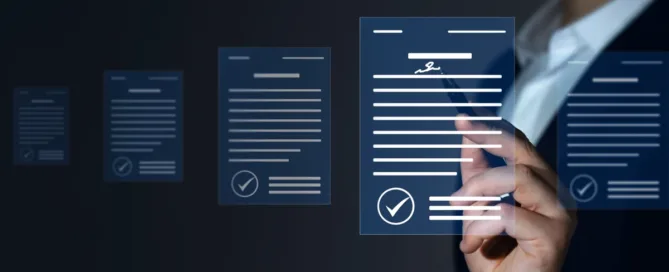Government operations globally are transforming to align better with the rapid pace of economic changes and the evolving needs of citizens. This is setting a new benchmark for efficiency and integration.
This article looks into the transformative world of digital innovation in government operations and explores how digital pioneers are setting new benchmarks for efficiency, transparency, and citizen engagement.
Join us as we unveil five key tips at this transformation’s core, guiding governments toward more effective and citizen-centric services.
-
Embrace Cloud-based Collaboration

Cloud-based technologies enable departments to share information and resources in real-time, significantly enhancing records management efficiency and service delivery.
A standout instance of cloud-based collaboration is the Dubai Digital Clouds project. Adopting advanced cloud services managed through green, carbon-neutral local data centers, Dubai sets a new standard in government operations. This approach supports economic growth and enhances the quality of life for its residents by improving the efficiency and reliability of public services. The initiative provides a comprehensive digital platform that facilitates data sharing among government departments.
It has transformed Dubai into a model for global digital cities, where cloud technologies play a crucial role in enhancing governmental efficiency and public engagement.
-
Automate to Innovate
In a push towards modernization, governments worldwide are embracing automation to enhance operations and allocate human resources toward more strategic tasks. A prime example of this shift towards process automation is evident in the Kingdom of Saudi Arabia, where the establishment of the Digital Government Authority marks a significant leap in automating government services and cultivating better coordination between ministries and state bodies.
This initiative aims to enrich citizens’ experience through providing more integrated services, significantly reducing duplication and enhancing efficiency. Leading the automation of services and ensuring a cohesive approach across various government entities, Saudi Arabia is streamlining administrative processes, ultimately leading to substantial cost and time savings.
Effective automation is only possible when all internal systems integrate well with each other. Where document management systems work in sync with correspondence management systems to deliver the right information at the right time to the right people, effective decisions can be made swiftly. This helps to speed up the delivery of government and public services to the end user. An example of this in action can be seen with Dubai Civil Defense and their use of NVSSoft solutions to improve efficiency in delivering emergency services to the citizens of Dubai. You can read more about how their use of Tarasol and ArcMate revolutionized their operations in our recent case study.
-
Leverage Data for Decisive Action
The integration of big data analytics is revolutionizing government operations across all sectors. It enables enhanced decision-making that significantly improves efficiency and public safety. By adopting big data, government agencies can gain macro-level insights that can drive substantial improvements across healthcare, urban planning, and environmental management.
In public safety, for example, the Dubai Police Force has integrated big data analytics into its operational framework. This strategic approach utilizes real-time data to assess and manage public safety concerns dynamically. The system provides first responders with comprehensive situational intelligence that includes historical data and predictive analytics concerning people, locations, and potential risks. This enhances the effectiveness of responses and significantly bolsters situational awareness.
With big data analytics, Dubai Police ensures that resource allocation is optimized and responses are both swift and well-informed. Such proactive use of data saves time and resources, strengthens community trust, and reinforces the government’s commitment to security and public welfare.
-
Achieve More with Less
In an era of tightening budgets and increasing demands for public services, governments face the challenge of doing more with less. Here, the efficient use of technology becomes crucial in maximizing the impact of limited resources while ensuring the delivery of modern, responsive services to the public.
A prime example of overcoming budget constraints through technological innovation can be seen in the United Arab Emirates. The UAE Ministry of Finance has made significant strides in incorporating robotic process automation (RPA) into its internal processes. This initiative has led to a dramatic increase in productivity and efficiency, with bots processing 1.8 million transactions with over 98% accuracy, saving 39,000 hours of human labor.
Before 2020, the Ministry identified several functions that could benefit from automation, including accounts payable, payroll and pensions, and financial accounting. The introduction of RPA into these areas enhanced operational efficiency and also improved employee satisfaction by reallocating human capital to more engaging and strategic tasks.
By 2022, the implementation of over 50 bots to handle various tasks autonomously resulted in notable achievements, including a 95% reduction in errors and a 65% decrease in average handling time. These advancements underline the critical role of automation in overcoming budget constraints and improving service delivery standards.
-
Build a Future-Ready Workforce

As government operations evolve with digital transformation, attracting, retaining, and effectively training a skilled workforce becomes imperative. The journey towards modernizing public services hinges on the government’s ability to build teams that are agile, tech-savvy, and aligned with the organization’s goals.The Center for State and Local Government Excellence in the US reports that 91% of agencies rank employee recruitment and retention as one of their highest priorities. A key reason for this is that a large number of government workers are at or near retirement age. In federal agencies in the US, 25% of workers are older than 55 and only 17% are younger than 35. Governments worldwide now face the daunting task of attracting new talent amidst stiff competition from the private sector, which often offers more lucrative incentives.
In response, many government and semi-government organizations are innovating their human resources practices to meet these challenges. Many government entities are transforming their onboarding process with digital portals, automating essential tasks like form submissions and training schedules. These portals help the integration of new employees and significantly shorten the time it takes for new hires to become productive.
Empowering Government Excellence: A Digital Transformation Blueprint
Digital transformation is pivotal for governments aiming to enhance efficiency, transparency, and citizen engagement. Embracing these concepts requires a robust digital backbone. This is where solution providers like NVSSoft can play a critical role by improving data flow and service integration across public sectors.
NVSSoft products are at the forefront of this transformation, helping streamline public services. The ArcMate suite of products improves efficiency through swift and accurate document capture, digitization, and management. Similarly, Tarasol, as a comprehensive case management system, enables smart collaboration through automated handling of correspondence, meetings, and cases, reinforced with electronic signatures.
Together, these solutions facilitate a more integrated approach to government operations. They can help to make public services more interconnected to meet the evolving needs of the communities they serve.
Eager to lead the charge in operational excellence and service delivery? Discover how NVSSoft solutions can transform your organization and contribute to building smarter, more responsive public services. Schedule a demo today and take a step towards a seamless digital future!







